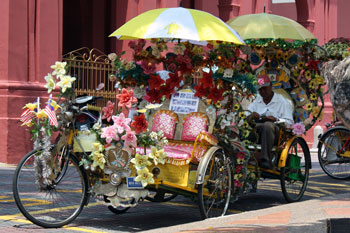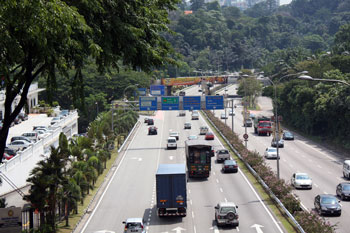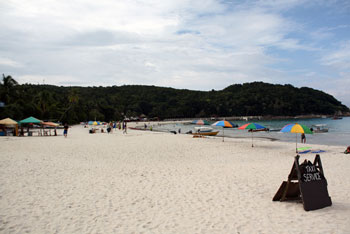 With this article I will take you on a trip to the confusing world of public transport in Peninsular Malaysia.
With this article I will take you on a trip to the confusing world of public transport in Peninsular Malaysia.
It’s an overview of the different ways to travel from one place to another and how we managed to (eventually) always get where we wanted to be.
There are plenty of different public transportation options from which to choose, and each of them has its own challenges, which sometimes have to be learned the hard way.
Skybus
On a sunny Sunday afternoon, after more than 30 hours of spending time in airports and airplanes, we finally arrived in Kuala Lumpur, the capital of Malaysia. Our hostel owner had been so kind to provide us some directions and this started with taking the “Skybus” to get from the airport to the center of the city.
As this is the most common way of airport transport, we figured that there would be at least some signs pointing to the right bus terminal…not. No problem, they can’t put a sign for every single bus company, we will certainly find the bus at the general bus terminal…wrong again.
Luckily there was this very nice taxi driver who could point us at least the direction of the Skybus terminal. At that time we probably already looked very lost, so thanks to mister cab driver to not trick us into his taxi! After having to ask for directions another couple of times, we finally managed to find the Skybus terminal at the other side of the airport.
We easily found the ticket office and soon we were on our way to Puduraya bus station.
Puduraya is the main bus station of central Kuala Lumpur and from there (according to my directions) it was only a couple of minutes walk to the hostel. Too bad the bus didn’t stop in the station, which made us lost again. After another round of asking directions, we found out that we were only one street away from the station, so soon we were on our way to the hostel.
At that time we called it bad luck, but it wouldn’t take long for us to experience the complexities of public transport in what I like to call a “semi-developed country”.
Metrobus
 The first trip we wanted to make around KL was to the famous Batu Caves. We asked the guy from the reception of the hostel how we should get there and in broken English he told us something about the metro and the bus. Now you have to know that in Dutch, and probably in some other languages too, “metro” is the name we give to the subway.
The first trip we wanted to make around KL was to the famous Batu Caves. We asked the guy from the reception of the hostel how we should get there and in broken English he told us something about the metro and the bus. Now you have to know that in Dutch, and probably in some other languages too, “metro” is the name we give to the subway.
As we didn’t really have a clue what the guy was talking about, I asked him to write it down. So he wrote the word “mertubus” and told us to go to central market.
Over there we started showing our piece of paper to everyone around, but nobody knew what the “mertubus” was. So we tried asking for some variations: “mertubus”, “merubus”, “metrubus”, “metrobus”… That last one rang a bell in the head of some friendly policemen who pointed us the way to a Metrobus bus stop. Indeed, I wrote “a” metrobus bus stop.
When the bus finally came we tried to wave him down but the driver waved back at us that this wasn’t the place where that bus stopped, so we had to run to a couple of streets further where the bus finally stopped at another bus stop.
Apart from a couple of liters of sweat nothing was lost and after half an hour we were dropped off at the Batu Caves. Some hours later we wanted to catch the bus back to KL city, but there didn’t seem to be any bus stops. At arrival we hadn’t really noticed that the bus dropped us off at the side of the road and that there wasn’t really a sign or anything.
So we guessed we should try to stand on the place where the bus dropped us off and sooner or later another bus would stop there and take us back to the city. Another bus stopped there, only to tell us that we were on the wrong side of the road (okay, we could have figured that out ourselves).
So we crossed the road and waited for another half hour until we finally noticed our bus in yet another road… Again some running brought us to the right imaginary bus stop and soon we were on our way back to the center.
Subway
To get to the KLCC PETRONAS towers, someone advised us to take the subway. No, actually that’s not true, someone really advised us to take the train. But luck was on our side and we figured out in time that in Malaysia people call the subway also a train. Otherwise we might still be waiting at the KL train station.
Unlike subway stations all over the world, in KL there’s a different ticket counter for each line. So you first have to find the right line, and then buy a ticket at the counter that sells ticket for that certain line.
After that, the “train” is piece of cake. It works similar to all other subways I’ve ever taken, and it soon became our favorite way of travelling.
Long distance buses
Too bad the subway only runs within a city, so whenever we needed to get from on the move we were dependent on other ways of transport. When we wanted to get from KL to Cameron highlands for example, we asked the guy from the hostel to arrange the bus. He did some phone calls, asked some money and wrote us a pre-printed paper which mentioned our names, the time of departure and the platform where the bus would leave.
By that time we were already a bit suspicious about public transport, so we arrived half an hour in advance at Puduraya bus station. Soon someone asked us where we wanted to go and showed us the way to platform 18. There was already a bus waiting but when we asked the driver if that was the bus to Cameron Highlands the answer was “No”. Nothing lost, we still had 20 minutes, so we waited…
After another 10 minutes the bus still hadn’t arrived and there also were no other passengers. So we started asking around. Nobody seemed to know about that bus, some even told us that what we had wasn’t a real ticket, but a friendly security guy took the time to run all over the station with us only to find out that the bus we needed didn’t exist.
By that time we were already more than half an hour late, so the only thing we could do was go back to the hostel and ask what was going on. The person at the reception did another couple of phone calls and found out that we had a wrong ticket. The bus didn’t leave at Puduraya, but across the street in front of the DiGi (a Malaysian telephone company) shop.
We received a new ticket and one hour later we were at the shop. There were already some other people waiting over there so our confidence came back and half an hour later we were on the bus to Cameron Highlands. I have to mention that we never made the same mistake again. From then on we always bought our tickets directly at the bus station and we haven’t had problems like this again.
Minivan
Between every tourist highlight there are at least a couple of minivan services. They are usually more expensive than long distance buses, but they pick you up and drop you off wherever you want. Another advantage is that these vans are usually scheduled to arrive at location around checkout time (11 – 12 am), which means you have more chance on finding accommodation.
But every coin has two sides, and so does this one. It seems like the drivers really feel like it’s their van and they are doing you a favor by bringing you to your next location (although you’ve paid for it) and thus you have no reason to complain about whatever they decide. So they decide on the music, both style and volume, on the temperature of the air condition, on the speed (wannabe rally drivers are no exception) and so on.
They also decide whether they stop or not along the way and if they do, where they stop and for how long. Of course, it is kind of funny to see a bunch of people sprinting to the toilets after a six-hour non-stop drive. Just make sure you’ve went before you leave and don’t drink too much along the way. And if you ate something funny the day before, you might want to consider not taking a van.
Taxi
 This is the kind of transportation we had the least problems with, I think. But of course you pay the price and we tend only to take taxis if there’s no other public transport available or if we have no clue where we are and where we need to be.
This is the kind of transportation we had the least problems with, I think. But of course you pay the price and we tend only to take taxis if there’s no other public transport available or if we have no clue where we are and where we need to be.
We experienced the taxi drivers as friendly and helpful persons. Because they know the area very well, most of the time they’re also able to give advice about good accommodation and sights.
Although most guidebooks will advise you never to take a taxi which doesn’t have a meter, I’ve always seen this as an advantage. You just need to make sure that you agree on the price before you leave, and it helps to look like you know the distance and about how much you should have to pay. When the price seems a little too much, it might also help to make a “hmmm-face” or to start talking to your companion in another language. This sometimes makes the drivers to reconsider their price.
When you’re at the coast or on an island, there are often boat taxis available. They normally go only to certain locations and they have fixed prices.
Boat
As mentioned before, there are the boat taxis, which are used for short distances, mostly to dive sites, other coasts or close islands. Next to that, there are the ferries. Different ferries exist towards the islands of Penang, Lankawi and Perhentian. But also to other countries like Indonesia.
The only experience we had with ferries was the one between Kuala Besul and Perhentian Kecil. It might take some time to figure out where the ferry specifically leaves. For example, when you want to leave Long Beach on Kecil by ferry, you first need to take a boat taxi to somewhere in the middle of the sea where the ferry then picks you up… You just need to know.
Train
Malaysia has two main train routes: one between Thailand and Singapore which passes by Penang and KL and close to Melaka, and another one between Kota Bahru and Gemas, which drives through Taman Negara.
The latter is also known as the “Jungle train”. In Gemas it switches tracks to either KL or Singapore, which provides a good connection between the city and the Jungle. The trains are old, and you should only take them for the experience, as the bus is cheaper, faster, more comfortably and they have and hourly schedule.
Adventurers as we are, it should be a shame not to give the jungle train a try. So in Taman Negara we went to the tourist info service to find out that the train to KL leaves Jerantut at 12:45, so at noon we were at the train station and found out that the train leaves 45 minutes past midnight… Living in a country where we use the 24 hour system instead of AM and PM, I know that I need to look out for this mistake, and honestly, I can’t remember if the timetable said “12:45 AM” or just “12:45”.
As there’s nothing to do in Jerantut which can keep you busy for more than 12 hours, and as there’s also a bus service every hour, we let go of the plan to take the jungle train and decided to take a bus instead.
Some extra notes about local buses:
Like the Metrobus in KL, every city has its own local bus service, but there are some things they have in common.
None of the local buses have a time table, but they drive quite often and you just need to appear on the right place and wait for a bus to pass by. Normally they have fixed hours when they start in the morning and stop in the evening, but we experienced that either this is a lie, or the people we asked just didn’t have a clue and made a guess.
Outside of the big cities, bus stops are not very common. Buses do stop, but don’t expect a sign or anything, so when you get off, always take a good look at the environment to be able to get back on again later.
Buses don’t always drive the same route. The advantage is that the driver might also bring you to a place where the bus normally shouldn’t pass by. The disadvantage is that it’s possible that the bus doesn’t pass by the place you expected, because it took a detour to drop someone else off. Make sure that whenever you get in, you tell the driver exactly where you want to get off.
Something else we’ve experienced is that people (even bus drivers) often don’t have a clue which bus goes where to. The tactic we’ve used is to ask at least five persons and take the bus which number has been answered most. But feel free to invent your own tactics.
You might have figured out by now that public transport in Malaysia is not that easy as it is in the western world. But luckily, it seems that the Malaysian government knows about this. One of our last days on the peninsula, I mentioned the problems we had to a Malaysian guy and he answered that their minister of transport has been to Europe to see how we handle these things over here.
So there’s hope!